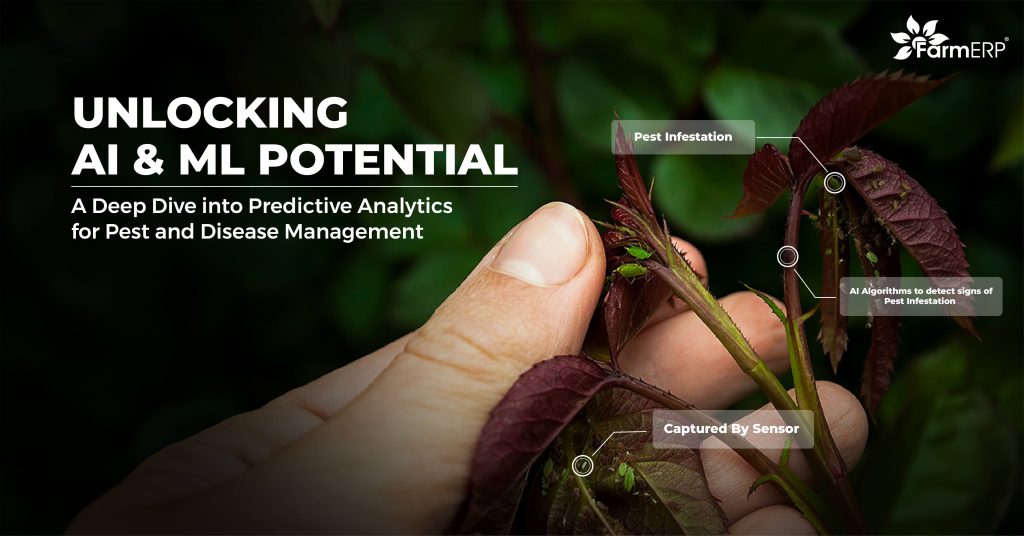Unlocking AI & ML Potential: A Deep Dive into Predictive Analytics for Pest and Disease Management

Pest and disease management is a critical aspect of modern agriculture. According to the Food and Agriculture Organization of the United Nations, global crop production losses due to pests and diseases are estimated at 20-40% annually, costing the global economy over $220 billion. Traditional pest and disease management practices rely heavily on manual monitoring, pesticide applications, and historical data, which often fail to provide accurate and timely interventions.
The advantages of artificial intelligence in agriculture are transforming pest and disease control. AI and ML enable real-time detection, early warnings, and precise interventions, ensuring better crop protection and sustainability. Predictive analytics techniques are at the forefront of this transformation, helping farmers make data-driven decisions to combat agricultural threats proactively.
The Growing Challenge of Pest & Disease Management
Understanding the Scale of the Problem
Farmers worldwide face increasing difficulties in managing pests and diseases. Climate change, globalization, and the development of pesticide-resistant pests have made traditional control methods less effective. The need for a data-driven approach to pest and disease management has never been greater.
Key Challenges in Current Pest Management Approaches
- Delayed Detection: Pests and diseases are often identified too late, leading to irreversible damage.
- Overuse of Pesticides: Excessive chemical use threatens biodiversity and human health.
- Lack of Accurate Forecasting: Conventional methods rely on past outbreaks, making them unreliable in changing climatic conditions.
- Cost and Resource Intensiveness: Manual monitoring is labor-intensive and prone to errors.
Impact of Pests and Diseases on Global Agriculture
Pests and diseases pose a severe threat to global agriculture, causing massive financial and food security challenges. According to estimates, farmers worldwide suffer billions in losses due to pest-related yield reductions, increased management costs, and crop quality deterioration. Invasive species like locust swarms can decimate entire harvests, while persistent diseases such as citrus greening and wheat rust weaken crops, further exacerbating food shortages and market volatility.
Beyond economic losses, pest and disease outbreaks disrupt supply chains, leading to increased food prices and reduced availability of staple crops. Farmers, who form the backbone of agricultural production in many developing nations, are particularly vulnerable, as they often lack access to advanced monitoring tools and rapid-response strategies. Addressing these challenges requires innovative solutions like predictive analytics techniques, which leverage AI and ML to improve pest and disease management practices and ensure global food sustainability.
- Economic Losses: Farmers suffer billions in losses due to reduced yields and increased control costs.
- Food Security Threats: Infestations like locust swarms, wheat rust, and citrus greening disease disrupt food supply chains.
- Market Disruptions: Reduced crop quality affects pricing, trade, and overall agricultural sustainability.
How is AI Used in Pest Management?
AI-powered tools are revolutionizing pest and disease management practices by detecting, monitoring, and controlling outbreaks with minimal human intervention. A review published by MDPI.com highlights that insects in a cotton farm can be detected with an accuracy of 70% to 98% using AI-based cameras and microphone sensors combined with enhanced deep learning algorithms.
Additionally, AI plays a pivotal role in the integrated pest management (IPM) approach by processing vast datasets on pest life cycles and environmental interactions. It powers predictive intelligence for early pest detection and outbreak forecasting. AI also optimizes control methods, ensuring the most economical and least hazardous pest management with minimal environmental impact.
Examples of AI in Pest Management:
- Computer Vision & Image Recognition: AI-powered drones and cameras analyze crop health in real-time.
- Sensor-Based Monitoring: IoT sensors track soil conditions and climate factors to predict pest risks.
- AI-Driven Pest Identification Apps: Farmers can upload images for instant pest diagnosis and control recommendations.
How AI & ML Analyze Vast Datasets for Early Detection
AI and ML-driven sensor-based monitoring plays a crucial role in pest and disease management by enabling precise, real-time detection. IoT sensors deployed across farms collect data on soil health, humidity, and temperature—key factors influencing pest activity. AI processes this information to identify early warning signs, allowing farmers to take preventive measures before infestations spread.
Predictive analytics further enhance this by tracking pest infestation patterns over time, using historical and real-time data to forecast potential outbreaks. By analyzing weather trends, crop conditions, and pest behaviors, AI helps farmers make informed decisions to mitigate risks effectively.
Hyperspectral and multispectral imaging add another layer of accuracy in early detection by capturing high-resolution images that reveal pest-induced stress in crops before visible symptoms appear. These imaging technologies, combined with AI data analytics in agriculture, to pinpoint affected areas and reduce the need for blanket pesticide applications.
To learn more about AI-driven crop management solutions, please check our blog: The Benefits of Crop Management Software for Farmers.
How Predictive Analytics Works in Pest & Disease Management
Predictive analytics combines AI, ML, and big data to provide real-time insights into pest and disease threats. By analyzing historical and real-time agricultural data, predictive models help farmers anticipate problems before they escalate.
Step-by-Step Process of Predictive Analytics in Agriculture:
- 1. Data Collection & Integrated Pest Management: Sensors, drones, and weather stations gather climate, soil, and pest activity data. By applying the integrated pest management method, AI integrates these datasets to assess risks.
- 2. Pattern Recognition & Risk Mapping: Machine learning models analyze past occurrences, detect trends, and create heat maps highlighting high-risk zones.
- 3. Predictive Modeling & Forecasting: AI uses climate patterns, humidity levels, and crop cycles to predict potential outbreaks. Farmers receive early warnings through mobile apps and dashboards.
- 4. Automated Decision-Making: AI-driven platforms recommend biological controls, organic pesticides, and site-specific treatments while enabling smart farming equipment for precision spraying.
Key Applications of Predictive Analytics in Pest & Disease Management
Predictive analytics is transforming agriculture by providing actionable insights that enhance pest and disease management practices. Below are key applications:
- 1. Precision Pest Control
AI-driven pest identification ensures that pesticides are used only when necessary, reducing excessive chemical applications and their environmental impact. - 2. Disease Forecasting & Prevention
Machine learning models analyze environmental conditions to predict when and where diseases are likely to emerge, allowing farmers to take preventive measures before outbreaks occur. - 3. Smart Crop Monitoring Systems
IoT-enabled sensors and drones provide real-time crop health data, detecting early signs of stress, pest infestations, or nutrient deficiencies, leading to timely interventions. - 4. Climate-Adapted Farming Strategies
AI-powered systems using satellite and drone imagery enable farmers to proactively apply climate-adapted farming strategies for pest and disease management, such as selecting pest-resistant varieties, intercropping, and using cover crops to enhance soil health.
Benefits of AI-Driven Predictive Analytics in Agriculture
The adoption of AI-driven predictive analytics in agriculture is transforming the way farmers manage pests and diseases. By leveraging machine learning and big data, these tools offer proactive solutions that minimize risks, optimize resource use, and enhance farm productivity. Here are the key benefits of integrating AI into agricultural pest and disease management:
- 1. Early Detection & Prevention
AI-powered predictive intelligence tools analyze real-time data to identify potential pest infestations before they escalate. By predicting outbreaks early, farmers can implement targeted interventions, reducing crop damage and safeguarding yields. - 2. Reduced Pesticide Dependency
With precise pest identification and risk assessment, AI ensures that pesticides are applied only when necessary. This minimizes chemical overuse, protects biodiversity, and supports environmentally friendly farming practices. - 3. Cost Savings for Farmers
By preventing large-scale infestations and reducing unnecessary pesticide applications, AI-driven solutions help farmers cut costs on pest control measures. This leads to improved profitability and long-term financial sustainability. - 4. Increased Crop Yields & Quality
AI-based predictive models assist in maintaining optimal crop health, leading to better-quality produce and yield improvement. Improved pest and disease management ensures that farmers can consistently meet market demands. - 5. Climate-Resilient Agriculture
AI integrates climate data to predict pest behavior in response to changing weather patterns. This helps farmers develop adaptive strategies that enhance resilience against climate-related pest threats, ensuring long-term agricultural sustainability.
Challenges & Future of AI in Pest Management
As AI and ML continue to revolutionize pest management, challenges remain in widespread adoption, infrastructure, and accessibility. While AI-driven solutions offer remarkable benefits, factors such as high implementation costs and limited digital connectivity pose barriers to their full-scale integration. Addressing these challenges is crucial for unlocking the long-term potential of AI in sustainable agriculture.
Current Challenges
- High Implementation Costs: AI adoption requires substantial investment.
- Data Gaps & Accessibility: Many regions lack real-time agricultural data.
- Infrastructure & Connectivity Issues: AI tools need reliable digital infrastructure.
- Farmer Adoption & Training: Widespread AI adoption requires farmer education.
Future Prospects & Innovations
- Integration with Robotics: AI-driven robotic drones for real-time pest control.
- Blockchain for Data Security: Secure analytics for pest and disease management through decentralized data sharing.
- AI for Small-Scale Farming: Affordable AI solutions tailored for smallholders.
To Conclude
The advantages of artificial intelligence in agriculture are reshaping pest and disease management. These analytic techniques provide a data-driven approach to pest and disease management, ensuring sustainable farming and yield improvement. To speed up this revolution, agribusinesses and research institutions must collaborate to make AI accessible to all farmers, unlocking its full potential for a resilient agricultural future.
To enhance your agribusiness and maximize farming output, explore FarmERP‘s advanced pest and disease management solutions. Get in touch with us today.
